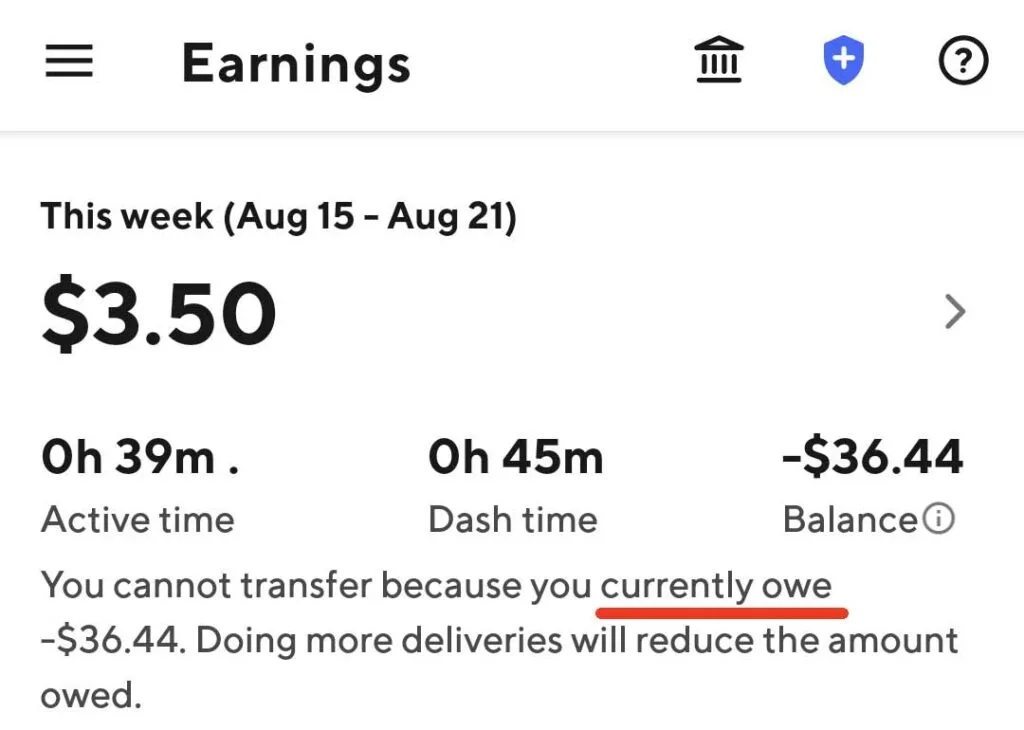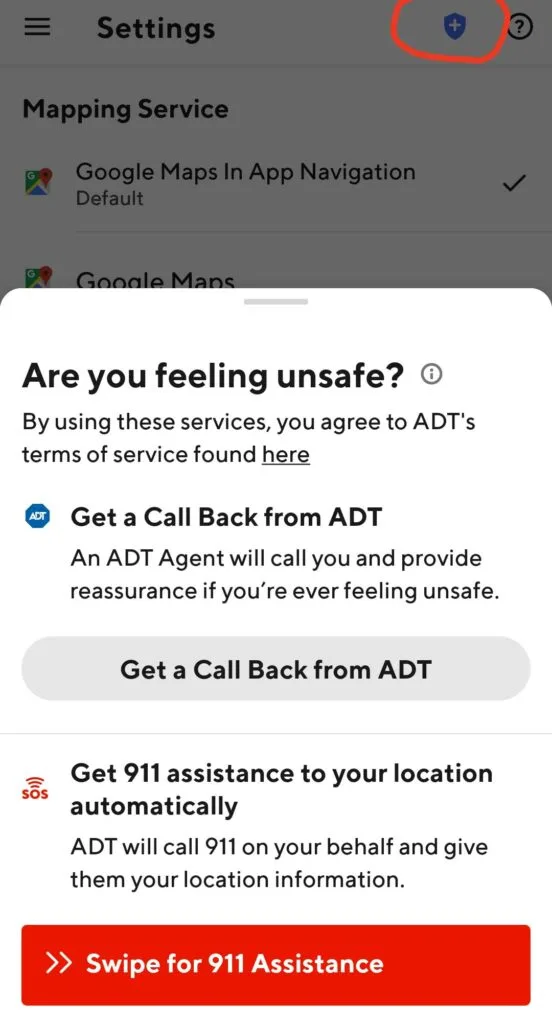Doordash has rolled out a cash-on-delivery payment option for customers. Some customers can now pay for their order with cash when the food is delivered.
How does cash on delivery work for the delivery driver? What do you do with the cash? Does cash on delivery make sense for Dashers?

I won’t tell you whether or not you should take these deliveries. That’s a decision you have to make for yourself based on your preferences. What I can do is talk about how it works, share my experience, and offer some pros and cons of cash delivery.
- How Doordash cash on delivery works
- Advantages of cash on delivery for Dashers
- Disadvantages of cash on delivery for Doordash drivers
- Final thoughts and questions
How Doordash cash on delivery works
Some customers may choose to pay by cash when they place a Doordash order. That means, instead of paying with a credit or debit card, they pay the total order amount in cash when the food is delivered.
When the food arrives, the customer pays the Dasher the entire amount for the order including the food, delivery, and service fees. The customer can choose to add a tip for the driver as well. The Dasher keeps the cash, and extra beyond the driver’s pay is applied to earnings from other deliveries.
In other words, the driver is paid part of their Doordash pay in cash.
Confusing? We’ll break it down and give examples of how it works.
The delivery order from Doordash
As a Doordash delivery driver, you may opt-in or out of cash deliveries. In the settings section of the Dasher app, you can toggle on or off for Cash on Delivery.
The offer screen will look a little different if a cash order comes in.

You’ll notice a couple of things about the screenshot above.
- The order type (black oval mid screen) says Cash on Delivery.
- The offer amount is for the Doordash delivery fee only and does not include tip (since any tip for this delivery would be in cash)
- There’s a light green bar that highlights the statement that the customer will pay for the order in cash.
- Instead of an accept button, the red button says See details. (I’ve seen some screenshots of other orders that still had Accept, so I don’t know if this was a recent change or if Doordash is testing different screens).
One thing that is immediately different about cash on delivery orders: You really have no idea what you will make because the customer’s tip is a complete wildcard.

When you hit the details, Doordash tells you how much the customer will pay. They explain what happens next, where the payment amount will be deducted from your total balance in your Doordash account.
It also states that you can reject the order without impacting your acceptance or completion rate. That means you have two chances to decide: on the original offer screen and again on the explanation screen.
Delivering the order.
Once you’ve accepted a C.O.D. order, the first part of the delivery is normal. You go to the restaurant and pick up the order.
You will not need to pay for the order unless the restaurant is one where you usually need to use a red card for payment.
Watching the experience of other drivers and with my own experience, all of the examples I’ve seen have been with Papa John’s deliveries. I don’t know if other restaurants are participating or if this will spread.
The delivery will obviously be one where you hand the food to the customer. Since the customer has to pay you for the order, it will not be a no-contact delivery.

The delivery itself should be straightforward. It’s just like any other delivery, except that you collect payment from the customer.
Doordash recommends that you carry some cash to give the customer change. However, they also stress to the customer that they are expected to have exact change.
If there are any issues with collecting the payment, a Dasher can tap o the “Issue collecting cash payment” button.
What happens to the money collected and how does this impact Dasher pay?
The Dasher keeps the entire payment. It does not have to be paid to Doordash or the restaurant.
That payment amount then gets deducted from accumulated earnings in your Dasher account. Then your delivery fee is added to your earnings.
In the first screenshot above, Doordash offered $3.50 to deliver. The third screenshot is from that same delivery, where the customer needed to pay $39.94. The customer paid $50.00, which amounted to a ten-dollar tip.
This was my first delivery of the week. As a result, my Dasher account had a negative balance ( -$36.44). $39.44 was deducted from my Dasher account, and then $3.50 was added to cover the delivery fee.

This is the earnings tab in my Dasher app after completing that delivery. I had a negative balance (-$36.44) and a statement that I can’t transfer any money because I owed $36.44.
Payments for the next several deliveries will get applied to that negative balance, and I won’t be able to transfer money to my DasherDirect card or get direct-deposited until after I’ve earned enough in future deliveries to pay off that balance.
If instead, I had accumulated $100.00 in earnings before this delivery, my balance would now be $60.06. In a way, it’s like I received a cash advance on money I would have taken out by Fast Pay, DasherDirect, or Direct Deposit.
When it was all said and done, with the customer paying $50, I made $13.56 on that trip. $3.50 for the delivery fee, and $10.06 was the cash tip. That’s not bad for a twenty-minute delivery.
Advantages of cash on delivery for Dashers
The main advantage for Dashers choosing to accept cash on delivery is more opportunities to earn.
An estimated 5.4 percent of U.S. households (approximately 7.1 million) were “unbanked” in 2019, meaning that no one in the household had a checking or savings account at a bank or credit union (i.e., bank).
FDIC: How American Banks: Household use of banking and financial services
Opening up opportunities for customers who don’t have a debit card or for those who choose to use cash means there are more orders to choose from.
Getting cash in hand instantly after completing a delivery is a benefit for drivers who prefer to use cash for more personal transactions.
Currently, rejecting cash-on-delivery offers does not lower your acceptance or completion rate.
I believe a customer is more likely to add extra money when paying in cash. A lot of people don’t want to bother with getting change and may be more likely to round up to complete the transaction quickly.
Disadvantages of cash on delivery for Doordash drivers
My first reaction when I heard Doordash was doing this was that they are now advertising to the general public that Dashers are carrying cash. Whether or not we opt-in to the cash orders, people perceive we will have money on us. In my opinion, this creates a tremendous safety risk for all Dashers, especially in high-crime neighborhoods and for night deliveries.
Dealing with cash itself can be a headache. Drivers who choose to take these orders must be mindful about carrying change with them.
Personally, I find that the cash option is a bit of a bookkeeping headache. I keep a business bank account separate from my personal checking account. Having all my payments come into that account, and all expenses taken out of that account simplifies things. Adding cash to the mix creates extra work.
Regarding accepting or rejecting Doordash orders, you don’t know what you will earn on a delivery. All you know now is the delivery fee. Whether the customer tips or not is a bit of a crapshoot.
Adding a cash payment to the customer interaction can lead to some headaches. It’s an opportunity for the customer to vent about the delivery cost. If the customer doesn’t have the payment or wants to pay with a large bill and you don’t have enough change, that adds time while you deal with support.
I wonder if the cash payment might often lead to smaller tips. There’s a stronger psychological feeling when paying cash than simply using a card, and the customer could be more likely to conclude that you will get paid more than you actually will be.
Final thoughts and questions
My first experience with a cash delivery turned out to be okay. The customer added a nice tip, which made it a profitable delivery.
When I received the order, I decided right away to take it just so I could know what the experience was like. It dawned on me that I didn’t have any cash after taking it. I quickly stopped at an ATM to take some money out, adding a few minutes to my delivery time.
There’s an odd feeling when on the one hand, I have fifty bucks in cash now, but on the other, I owe Doordash $36. It will only take a few deliveries to even that out.
One thing this reminds me of is when Uber Eats changed up their delivery offers in late 2019. They previously had not displayed any pay amount when offering a delivery, so you were totally in the dark about what you would receive. When they first made a change, they only showed the delivery fee. It was a lot like these cash-on-delivery offers from Doordash, where you have no idea if there will be a tip or what it will be.
For me, not knowing the total amount is not a deal breaker. You have to treat it differently and play the averages a bit more. You know the order amount, and that gives you an idea of what the tip might be. It won’t always be what you think it would or should be, but if you’re good at estimating, the averages play out over time.
Should you take cash deliveries? That’s entirely a personal decision. I think you have to weigh the advantages and disadvantages and see which ones resonate the most with you.
How much change should I carry for cash on delivery orders?

It’s probably a good practice to start with about $20.00 in change. Two fives and ten one-dollar bills will handle most situations.
Should you carry more than that in the event of larger orders? I think it’s debatable.
Say the order is $60, and the customer has a $100 bill. Not having enough change will slow you down a lot in trying to deal with the whole thing.
At the same time, Doordash stresses to the customer that they need to have the exact change, and carrying the additional amount could encourage customers to continue that practice.
One decision you have to make is, is it better to accommodate the customer and be done with the delivery quickly, or should you stand on the principle that they were supposed to have the exact amount? Remember that the more you make an issue of things, the more you jeopardize getting a tip.
What happens if I don’t have enough change for the customer?
Tap on the “Issue Collecting Cash Payment” button (the grey button in the screenshot further up in this article). Then tap on “I do not have any change.”
At this point, Doordash will give you instructions. It may involve Dasher support. Doordash may instruct you to go ahead and deliver the food or may have you not complete the delivery. They’ll still pay you for the delivery.
If you do not collect cash, be absolutely sure that Doordash knows that before closing out the order. You do not want to be charged for the order.
What if you can’t find the customer or the customer doesn’t want to pay?
Do not deliver the order. Tap on “Issue Collecting Cash Payment and choose the following option that is appropriate:
- Customer was short on cash
- Customer unavailable
- Customer refused to pay
Doordash says that in those instances, you would not deliver the food. Doordash support may get involved, or the app may give you instructions about what to do with the order. If you do not complete the order, you will still get your base pay, and your completion rate is not impacted.
Unfortunately that means you won’t get a tip either.
What if I feel unsafe because of the cash I’m carrying?
In a situation where you feel unsafe, you can tap the blue button at the top of the Doordash driver app. That will open up the ADT SafeDash screen.
This gives you two options. Tap a button to request someone from ADT to give you a call, or swipe another button to have ADT call 911 for you.

Will I get so many cash orders that I can’t pay it back?
Doordash will not send any more cash on delivery offers if you have a negative balance in your Doordash account. You can see the account balance by tapping the menu bars and selecting Earnings.


